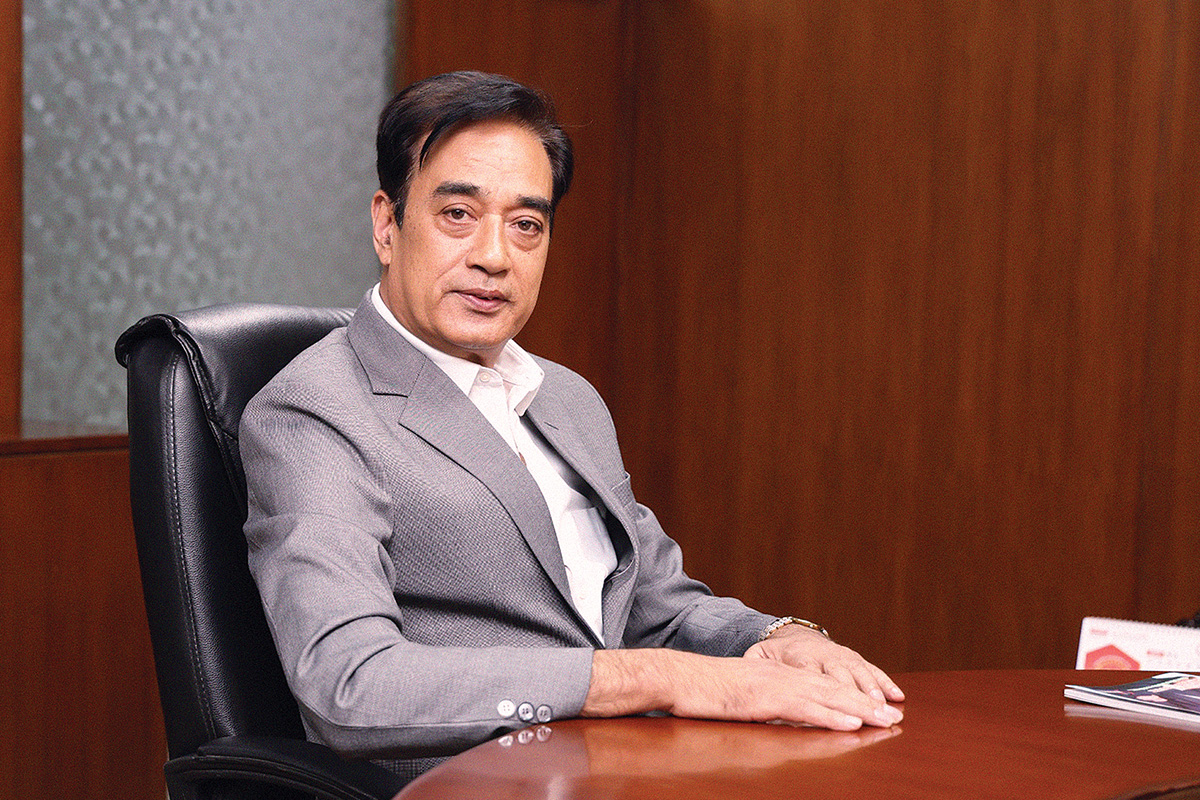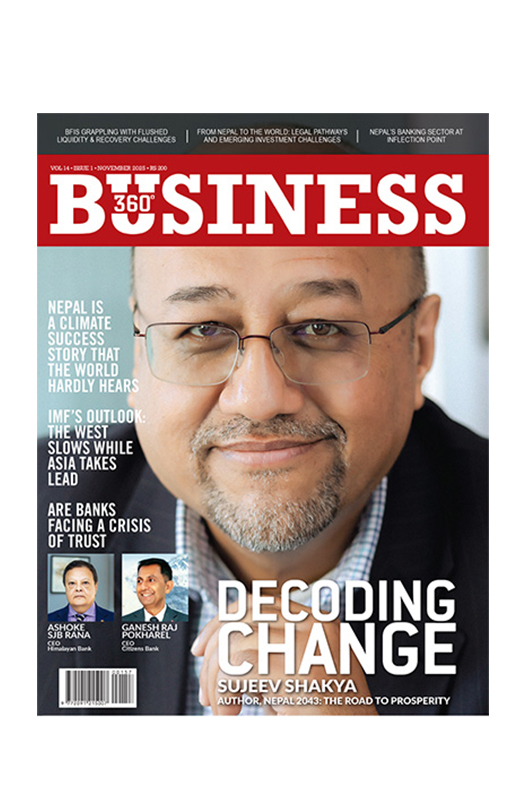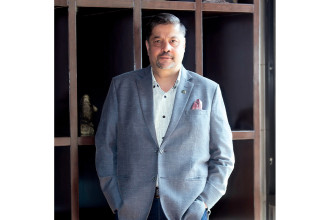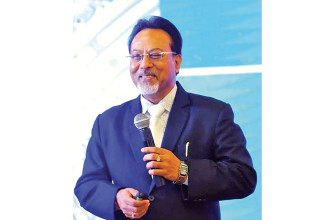
Rajendra Malla
President, Non-Life Insurance Association
“FROM THE INITIAL ESTIMATES, I BELIEVE TOTAL CLAIMS WILL EXCEED RS 20 BILLION, POSSIBLY MORE ONCE ALL SURVEYS ARE COMPLETED. WHILE THAT NUMBER IS DAUNTING, IT IS WITHIN THE CAPACITY OF NEPAL’S INSURANCE SECTOR TO HANDLE, ESPECIALLY WITH THE BACKING OF INTERNATIONAL REINSURERS. I WILL SOON BE CONVENING A BOARD MEETING WITH THE NEPAL INSURANCE AUTHORITY TO ENSURE WE COORDINATE OUR RESPONSE AND KEEP THE PROCESS MOVING QUICKLY”
THE GOVERNMENT ITSELF SHOULD INSURE ITS ASSETS, NOT ONLY TO PROTECT THEM BUT ALSO TO SET AN EXAMPLE FOR THE PUBLIC. IF THE STATE SHOWS THAT INSURANCE IS A PRIORITY, CITIZENS AND BUSINESSES WILL BE MORE LIKELY TO FOLLOW SUIT.
The Gen Z led protests shook Nepal not only politically but economically, leaving a trail of destruction that impacted both private and public assets. From torched vehicles to gutted offices, the unrest raised pressing questions about the country’s readiness to protect its property and people against sudden crises. Insurance, often overlooked in Nepal, suddenly became central to the national conversation.
To understand the true cost of the damage, the capacity of Nepal’s insurance sector, and lessons that must be learned, Business 360 spoke to Rajendra Malla, President of Non-Life Insurance Association of Nepal. In this interview, Malla shares his assessment of the losses, the role of insurance in rebuilding, and the urgent need for greater awareness among citizens and policymakers alike. Excerpts:
The protests took a violent turn causing widespread destruction. How extensive is the damage, both insured and uninsured?
At this stage, we are still relying on preliminary estimates, as full surveys have yet to be completed. That said, early figures suggest that the private sector alone has endured losses of around Rs 22–Rs 23 billion. This includes damaged offices, factories, hotels, vehicles and retail establishments. These numbers are not final but they provide a sobering picture of how badly the economy has been hit.
If we include government property, however, the figures rise dramatically. Major buildings like Singha Durbar, Presidential Office, and even the Supreme Court have suffered damage. Taken together, public and private losses likely run into the trillions. To put that in perspective, even if Nepal devoted its entire development budget for four or five consecutive years, it still might not be enough to fully rebuild.
The problem is compounded by the fact that most government vehicles are only covered under third-party policies, not comprehensive insurance. That means the financial burden of replacing or repairing them falls entirely on the state. Every time unrest erupts, we damage assets that belong to the people, and in the end, it is the citizens who pay the price through stalled development.
For the uninsured, particularly in the private sector, what options are there for recovery?
Those who lack insurance face very limited options. Small businesses, households, and even some private offices have no protection because many owners never considered insurance necessary. Typically, insurance in Nepal is taken only when a loan is required from a bank. Otherwise, people believe they can manage without it. This mindset is dangerous. When disaster strikes, uninsured businesses and families are left with nothing. They either close down entirely or fall into debt trying to recover. This is why I keep stressing that insurance is not a luxury, it is a lifeline. A premium of just a few thousand rupees can save a business or a family from losing millions. Unfortunately, that lesson is often learned only after tragedy.
Based on what you have seen so far, how much will it take to restore and rebuild everything that has been destroyed?
If we consider both physical structures and human needs, the total cost runs into billions of rupees. And it is not just about bricks and mortar. Restoring livelihoods, replacing lost income and repairing public trust are also part of the rebuilding process. Taken together, I would say the setback is equivalent to losing five years of development progress.
What makes it more discouraging is that Nepal seems to face a major disaster or crisis every five years. In 2015, it was the earthquake. In 2019, the pandemic struck. And now, in 2025, we are dealing with massive destruction caused by protests. The intentions behind the Gen Z movement calls for political reform and youth leadership and carries an important message. But the damage to our assets and infrastructure has left the country with a heavy burden.
How do non-life insurance policies classify damages caused by riots, vandalism or terrorism?
Insurance is essentially a system of risk-sharing. In Nepal, insurers typically cover up to 35% of damages themselves. Anything beyond that is passed on to international reinsurers. For example, if damages amount to Rs 1 billion, a local insurer might cover Rs 350 million, while the remainder is shouldered by reinsurers abroad. This system allows us to manage large claims without collapsing under the pressure. However, every reinsurance agreement has a cap, so there are limits. Events of this scale test the boundaries of our system and remind us of the importance of careful planning and strong reinsurance partnerships.
From the initial estimates, I believe total claims will exceed Rs 20 billion, possibly more once all surveys are completed. While that number is daunting, it is within the capacity of Nepal’s insurance sector to handle, especially with the backing of international reinsurers. I will soon be convening a board meeting with the Nepal Insurance Authority to ensure we coordinate our response and keep the process moving quickly.
Does Nepal’s insurance industry have the strength to settle such large claims without destabilising itself?
It will not be easy, but yes, we have the strength. Every insurance company maintains reserve funds for exactly these kinds of events. Collectively, these reserves amount to billions of rupees. If necessary, companies may even mortgage their own properties or take on loans to ensure policyholders are compensated.
Insurance only works if people can trust it. If companies fail to honour claims during a crisis, confidence in the entire system collapses. That is why we are determined to meet our obligations, no matter how difficult it may be.
With many records and documents destroyed, how will insurers verify claims?
Verification is always a challenge in times of mass destruction. The process begins when policy holders submit formal applications, either in writing or electronically. After that, surveying engineers are sent to inspect the damage and prepare reports. In large cases, international surveyors may also participate.
Based on these reports, claims are calculated, and payments are initiated. To ensure speed, many companies are already holding internal meetings to streamline the process. As president of the association, I will also bring together insurers to align our efforts with the national recovery agenda.
How long does this claims process usually take?
There is no strict timeline but the guiding principle is urgency. We understand that businesses and households need funds immediately to begin rebuilding. While some cases may take longer due to complexity, our commitment is to fast-track as many claims as possible. It is always better to settle quickly rather than delay payments unnecessarily.
Do you believe Nepal needs new insurance products tailored to situations like this?
Yes, absolutely. Our current product portfolio covers many risks but the penetration of insurance in Nepal is still very low. Most small businesses and households remain uninsured. We need policies that are accessible, affordable and well understood at the grassroots level.
Awareness is key. Even a small premium can provide massive protection but people do not realise this. Insurance should be treated as a routine part of running a business or owning property, just like paying taxes or maintaining staff salaries. Without it, crises like this leave people with no safety net.
Do most public offices and government buildings have insurance coverage?
The reality is that most do not. Some newly constructed offices may have policies but the vast majority of government assets are uninsured. When these buildings are damaged, the cost of rebuilding falls directly on the state, which means on taxpayers.
This is a structural weakness. The government itself should insure its assets, not only to protect them but also to set an example for the public. If the state shows that insurance is a priority, citizens and businesses will be more likely to follow suit.
Can the burden of losses be shared more fairly among insurers, government and taxpayers?
In practice, it already is. Insurers are using their reserves, the government is reallocating funds, and ultimately, taxpayers will bear part of the cost. What we need is better coordination so that the burden does not fall disproportionately on any one group.
Personally, I believe insurers also have a civic responsibility. If needed, we must go beyond our business obligations and contribute in whatever way we can. After all, we are also Nepali citizens, and national recovery is everyone’s responsibility.
How important is reinsurance in this process?
Reinsurance is absolutely essential. Without it, local insurers would be overwhelmed by claims of this scale. International reinsurers spread the risk globally, ensuring that catastrophic losses in Nepal can be absorbed without bankrupting our companies.
For small claims, reinsurers may rely on local reports. For large-scale damages, they send representatives to verify the losses themselves. This system ensures accountability and makes sure claims are paid fairly.
Looking ahead, what reforms are most urgently needed in Nepal’s non-life insurance sector?
The number one reform is awareness. Insurance should not be seen as optional or secondary, it should be a standard practice. Public campaigns, led by both insurers and the government, are critical. People need to understand that insurance is not about profit but about protection.
Regulatory reforms could also help. Nepal Insurance Authority already plays an important role but its resources could be directed more toward education and awareness. We should also study international best practices and adapt them to Nepal’s context. Our aim should be to respond faster, more efficiently and with greater transparency.






